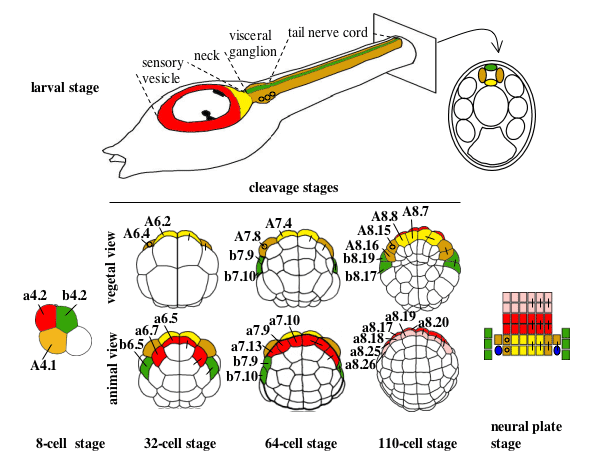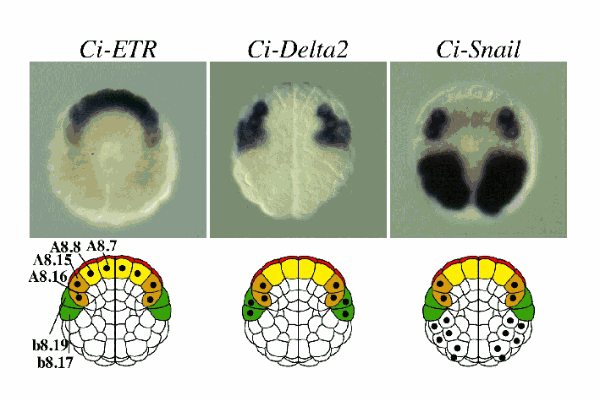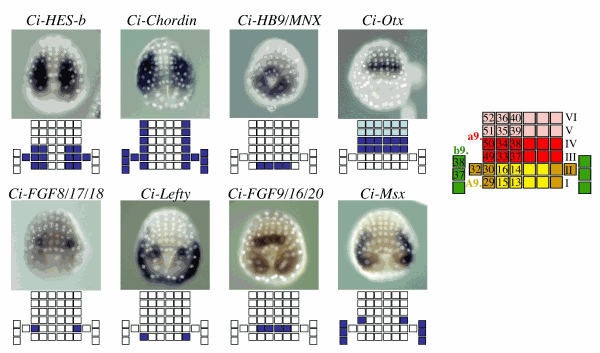As well as the neural cells which come from the vegetal A-line cells from a cell fate choice between neural and notochord (see project 1), CNS precursors are also specified in the animal cells (a-line and b-line) following cell fate decisions between neural and epidermal fates.

In order to form a fully developed CNS, the neural cells, once generated, obtain positional information which govens patterning along the dorsal-ventral and anterior-posterior axis. This leads to the generation of specific cell-types in the CNS, such as the motoneurones which form in the ventral-lateral part of the visceral ganglion (see Fig.1). Patterning of the neural cells begins as early as the early gastrula stage, when we first see a difference in the genes expressed between the medial and the lateral A-line neural precursors (Fig.2).

By neural plate stages, expression of genes can be found in specific anterior-posterior as well as dorsal-ventral domains.

We are analysing cell-cell interactions, cell signalling pathways and transcriptional gene regulation to try to understand how the patterning of the neural plate is generated

Laboratoire de Biologie du Développement UMR 7009
Cette UE se déroule sur 2 semaines et a lieu au laboratoire de Biologie du Développement de Villefranche -sur-Mer (LBDV). Elle inclut l’examen de l’UE d’analyse scientifique (5V089) suivie par les étudiants de la spécialité de Biologie du Développement.
Durant la 1ère semaine, les étudiants participent à des ateliers et des rencontres avec les chercheurs du laboratoire.
Durant la 2ème semaine, les étudiants sont répartis dans les équipes pour y réaliser un mini projet qu’ils présentent le dernier jour du cours. Le cours est donné en anglais pour tout ou partie.
Modalités d’évaluation
Présentation orale du mini-projet (binôme, 100 %)
UE en anglais (partiellement ou totalement)
Master BMC, S3, 6 ECTS
Code UE: 5V200
Responsable de l’UE: Carine BARREAU (MCU): carine.barreau [at] obs-vlfr.fr
Cette UE permet aux étudiants de 1ère année de Master de passer 2 semaines à l’Observatoire Océanologique de Villefranche-sur-Mer. Le cours est obligatoire pour les étudiants du Master Biologie Intégrative, parcours Biologie et Bioressources Marines (BBMA) tandis qu’il peut être choisi en option par les étudiants du Master Biologie Moléculaire et Cellulaire (BMC). Les étudiants participent à des ateliers de présentation des organismes marins utilisés par les équipes de recherche du laboratoire (LBDV) et apprennent à les manipuler au cours de travaux pratiques dont les thématiques vont de la Biologie du Développement fondamentale à la toxicologie appliquée.
Modalités d’évaluation
Analyse d’article et présentation orale (50%)
Compte-rendu écrit de TP (50%)
UE partiellement en anglais
Master BIP, S2, 6 ECTS
Code UE: 4B022 (ouverte au Master BMC)
Responsable de l’UE: Carine BARREAU (MCU): carine.barreau [at] obs-vlfr.fr
Cette UE complémentaire se déroule sur 2 semaines et permet aux étudiants de découvrir les différents aspects (métiers & recherche) de l’Observatoire Océanologique de Villefranche-sur-Mer (OOV). Ateliers et journal clubs sont organisés afin que les étudiants mettent en pratique leurs connaissances théoriques en biologie et développent leur capacité de communication scientifique en français et en anglais.